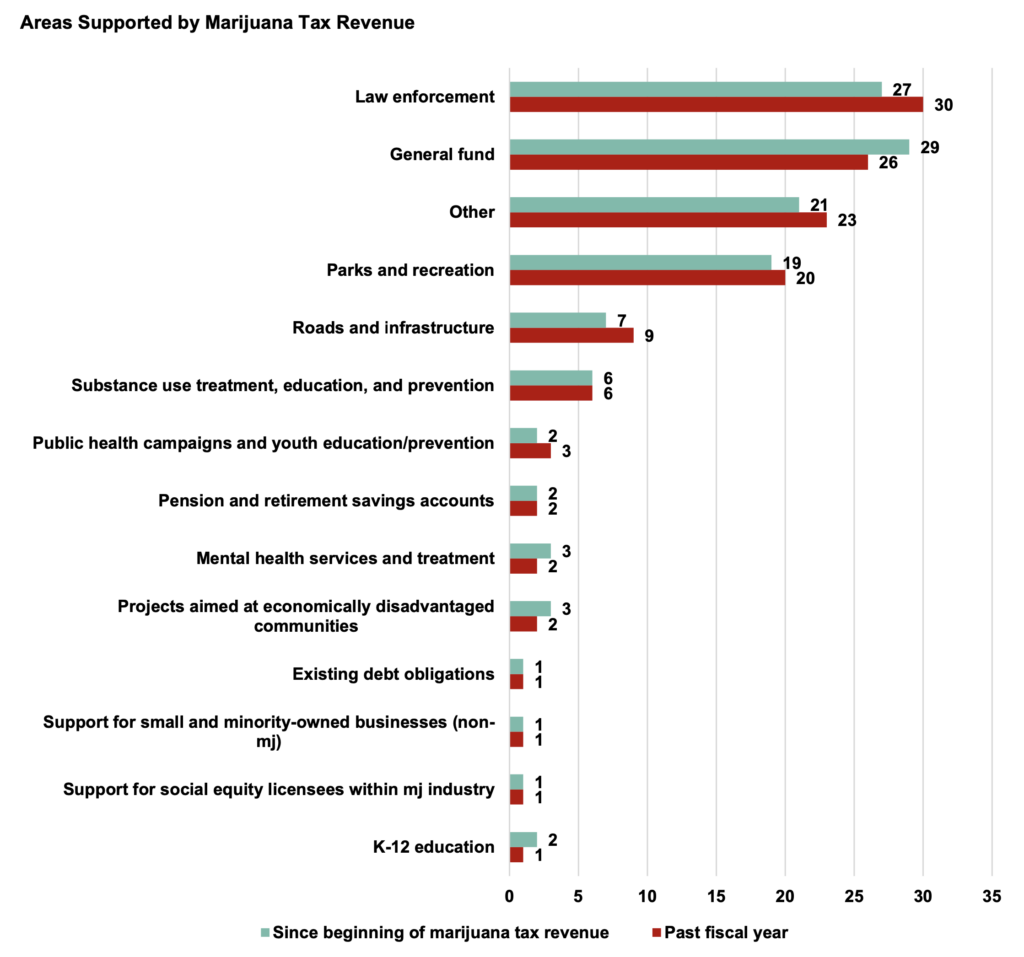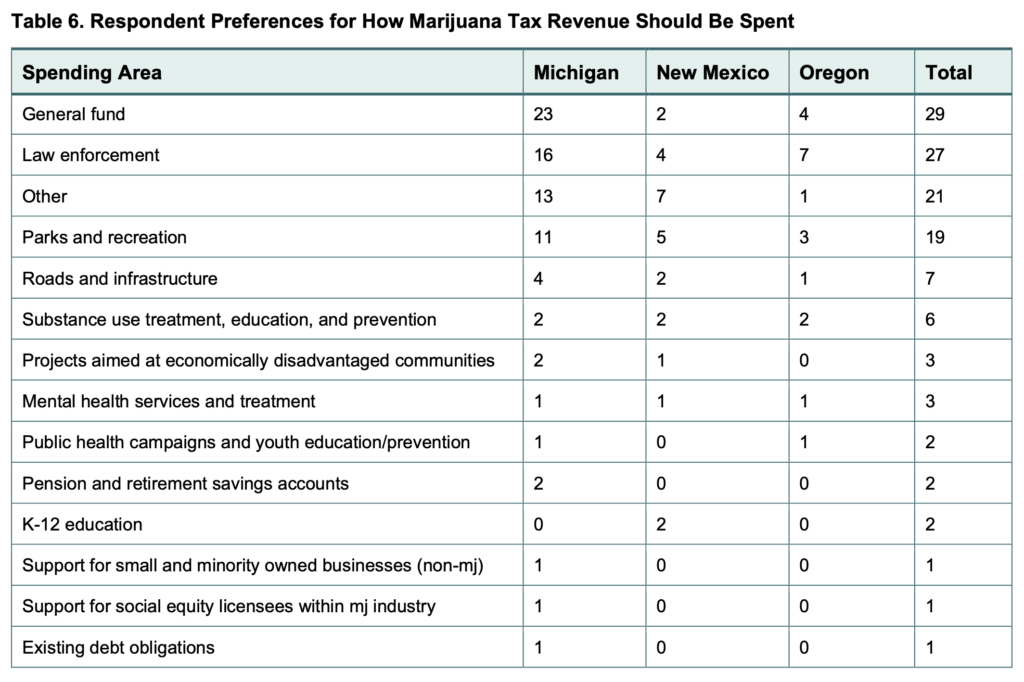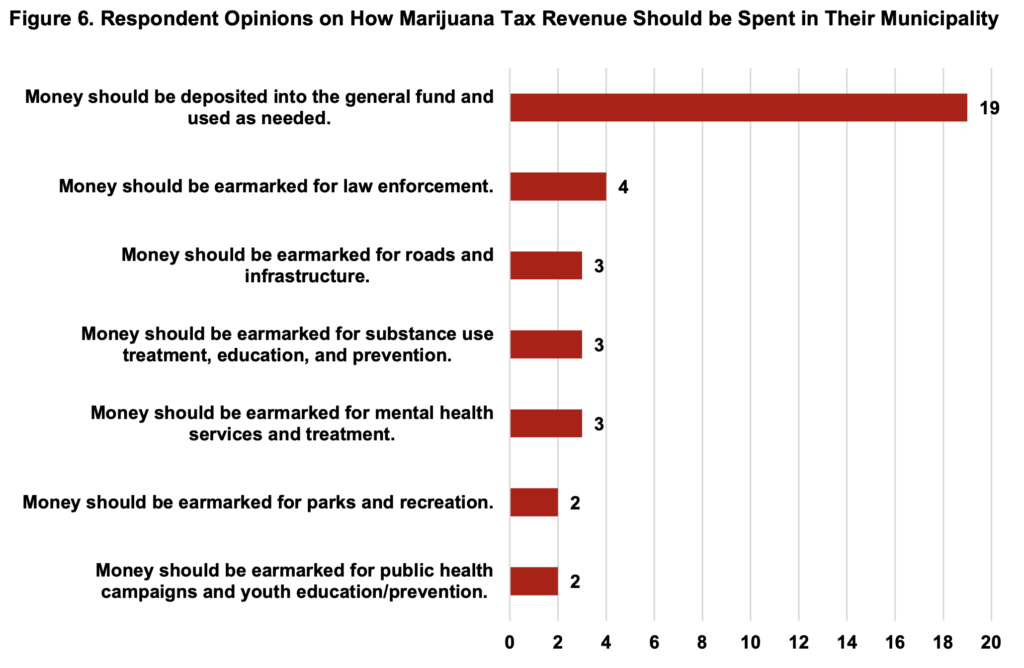Cities Mostly Put Marijuana Tax Revenue Toward Police And General Funds Instead Of Education And Health Programs, New Study Shows
FeaturedMarijuana IndustryMarijuana Industry News November 20, 2024 MJ Shareholders 0
The bulk of local tax revenue from legal marijuana goes toward law enforcement and municipalities’ general funds, with relatively few cities and towns allocating cannabis-generated funds to support education or health programs.
That’s according to a new study from researchers at the Ohio State University’s Moritz College of Law, with authors saying the findings represent the “first systematic exploration into how local governments spend or are planning to spend marijuana tax revenue.”
The review looked specifically at three U.S. states with existing adult-use cannabis programs—Michigan, New Mexico and Oregon—as well as Ohio, where marijuana sales began in August but tax revenue has not yet been allocated to local governments. Researchers reached out to 501 localities across the four states, and heard back from about a third of them.
“The survey responses indicate the most frequent utilization of marijuana tax revenue funds involve three areas,” the report found: “depositing revenue into the general fund for use as needed, supporting local law enforcement, and funding parks and recreation in local communities.”
Authors said the results were “especially interesting with respect to smaller jurisdictions,” noting that more than 3 in 4 (76 percent) of respondents represent localities with fewer than 25,000 residents.
Most localities said cannabis tax revenue went into general funds. Across all respondents, a majority (60 percent) “indicated that the money is deposited into the general fund and used as needed.”

Hrdinova et al. / OSU Drug Enforcement and Policy Center
That varied significantly across Michigan, New Mexico and Oregon, however. In Oregon, authors noted, 78 percent of respondents “indicated the use of a general fund,” while fewer than half (47 percent) of Michigan localities did so.
“Twenty-six percent of all respondents indicated that marijuana revenue is used for a specific purpose, with some of them (14%) stating that this purpose does not change year to year and others reporting that the purposes change periodically (12%),” the report says. “An additional 12% of participants reported that some portion of marijuana tax revenue is designated for specific purposes and the rest is deposited into a general fund for use as needed.”
On average, the plurality (47 percent) of jurisdictions received between $50,000 and $250,000 apiece.

Hrdinova et al. / OSU Drug Enforcement and Policy Center
In addition to asking local jurisdictions about the amount of tax money received and how it’s spent, researchers also queried municipalities about how they felt revenue should be spent. Responses to that question largely align with current spending priorities, they found.
“Most believed it should be deposited into the general fund, although there was some variation across states with respondents from New Mexico selecting “Other” most often and respondents from Oregon favoring law enforcement,” the paper says. “Law enforcement was the second most popular choice overall, followed by “Other” and parks and recreation.”

Hrdinova et al. / OSU Drug Enforcement and Policy Center
It’s not necessarily the case that those views from officials align with the opinions of the residents they serve. A study published earlier this year in the International Journal of Drug Policy found that residents of New Jersey, for instance, felt cannabis revenue should fund education and housing, not police or anti-drug campaigns.
As Ohio begins collecting and distributing cannabis taxes, researchers advised, “the state should actively collect data not only on which municipalities and townships receive marijuana tax revenue and how much, but also on how local government spend this revenue.”
Among 21 surveyed Ohio municipalities, less than a third (29 percent) said local leadership teams have already discussed how to spend marijuana tax revenue, while more than half (62 percent) said they have not discussed spending but have plans to discuss it in the near future. About 10 percent said they hadn’t had any discussion.
“Of the six respondents that have already discussed their plans for how to spend future marijuana tax revenue,” the report says, “four planned to deposit the tax revenue into the general fund and use it as needed, while two stated they had not made concrete plans.”
Ohio officials similarly indicated they felt general fund and law enforcement were the best uses of cannabis tax revenue in their municipalities.

Hrdinova et al. / OSU Drug Enforcement and Policy Center
Since sales of legal adult-use marijuana began in the state in August, retailers have already sold more than $131 million worth of cannabis products. The state has a 10 percent tax on all non-medical marijuana at the point of sale.
Research published in May by the advocacy group Marijuana Policy Project found that states have generated more than $20 billion in marijuana tax revenue since the first markets opened a decade ago.
According to a review of separate federal data, states have collected at least $8.7 billion in cannabis taxes since 2021.
At the state level, many jurisdictions have earmarked considerably more cannabis tax revenue for community reinvestment.
California officials in June, for example, awarded another round of community reinvestment grants to nonprofits and local health departments, funded by marijuana tax revenue. The Governor’s Office of Business and Economic Development (GO-Biz) announced the recipients of over $41 million in awards, the sixth round of cannabis-funded California Community Reinvestment Grants (CalCRG) under the state program. In March, officials awarded $12 million in marijuana tax-funded grants to cities across the state to support equity programs for people disproportionately impacted by the war on drugs.
The latest report from DEPC @OhioStatelaw provides the first systematic exploration into how local governments spend or plan to spend marijuana tax revenue in states that allocate part of that revenue to local governments.
Explore our survey results: https://t.co/8ZRnlh8LwR pic.twitter.com/ZNNaJ6ltPx
— Drug Enforcement and Policy Center at Ohio State (@OSULawDEPC) November 18, 2024
And in Illinois earlier this year, officials announced that they’re awarding $35 million in grants to 88 local organizations, using funds generated from taxes on adult-use marijuana sales to support community reinvestment efforts.
The funding is being offered through the state’s Restore, Reinvest, Renew (R3) Program that was established under Illinois’s 2019 legalization law. It requires 25 percent of cannabis tax revenue to support areas most harmed by the “disproportionate damaged caused by the war on drugs,” the Illinois Criminal Justice Information Authority (ICJIA) said.
Since launching the R3 program, Illinois has awarded over $244 million in marijuana revenue-funded grants to that end.
In New York, meanwhile, cannabis regulators last month began accepting grant applications for a $5 million community reinvestment program funded by marijuana tax revenue. The effort, which will support services such as mental health, workforce development and housing for young people, is part of an push to reinvest state cannabis monies in areas “disproportionately affected by prior federal and state drug policies in order to redress a wide range of community needs.”
MJ Shareholders
MJShareholders.com is the largest dedicated financial network and leading corporate communications firm serving the legal cannabis industry. Our network aims to connect public marijuana companies with these focused cannabis audiences across the US and Canada that are critical for growth: Short and long term cannabis investors Active funding sources Mainstream media Business leaders Cannabis consumers










No comments so far.
Be first to leave comment below.